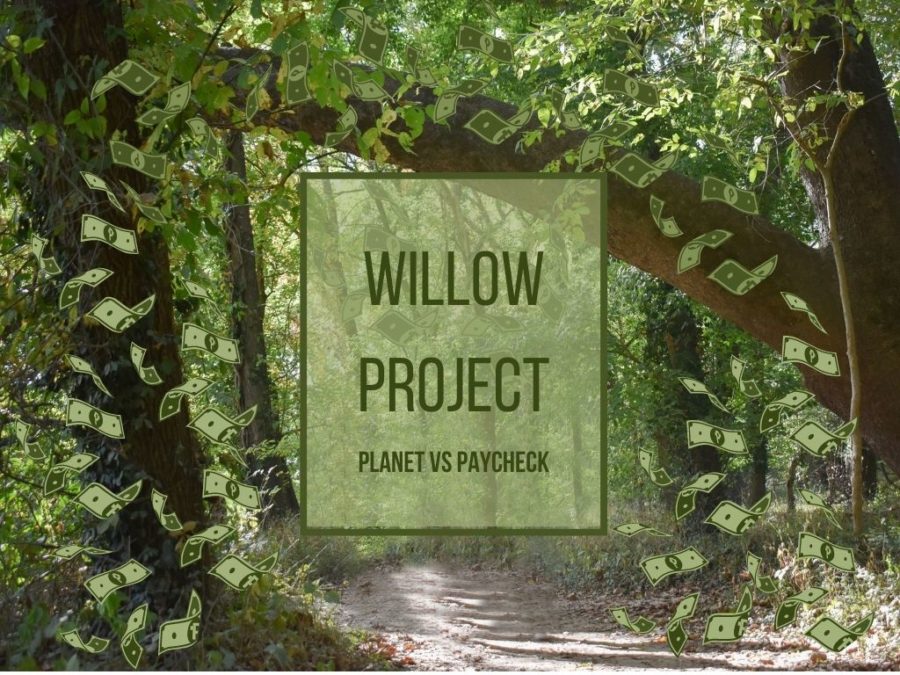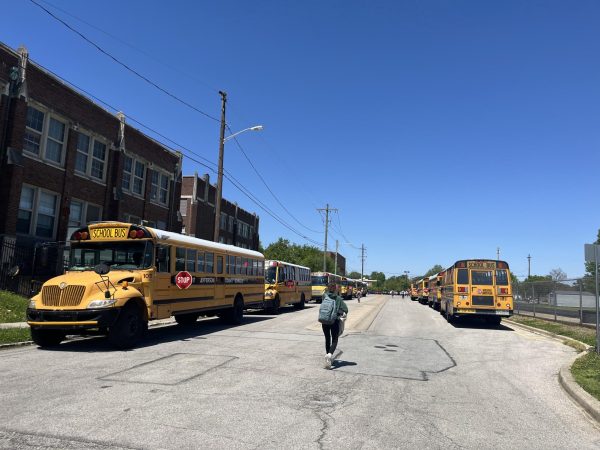Willow, at what cost?
The approval of the massive oil drilling Willow Project in Alaska raises a debate on its environmental and economic consequences for the United States
The Biden administration’s approval of the Willow Project to begin production in Alaska has sparked an uproar of protest on social media within the past month. The green light for such a massive oil drilling project leaves many questioning whether environmental activism is being prioritized at the governmental level. “The Willow Project being approved puts a lot of uncertainty about [the] types of politicians we can trust,” sophomore Amelia Geistler said.
April 17, 2023
In the past month, the name “Willow” has not been unfamiliar to many across the United States. From thousands of TikToks with the trending hashtag #Stop Willow to a social media petition that raised millions of signatures to lawsuits filed against the Biden administration by the environmental group Earthjustice and law firm Trustees for Alaska — the passing of the oil drilling Willow Project in Alaska has unveiled depths of controversy across the nation.
Alaska faces an extensive economic and environmental fight through implementing this new project. But the debate that has ensued regarding the Willow Project’s benefits to the global community is one that has become a political standoff rather than an economic or environmental discussion. In the heat of it all, the surplus of information on the topic has led to ignorance of the hard facts of the issue, leaving many unaware of what the Willow Project desires to implement in Alaska and its impact on the future of America’s oil industry.
The issue primarily began long before the hashtags and the social media petitions. In fact, the initial discovery of approximately 3 billion barrels of crude oil in the Willow region of Alaska occurred in January 2017. The Houston-based petroleum refinery company ConocoPhillips discovered the surplus of natural resources in the northern territory of the previously established National Petroleum Reserve in Alaska. The company, known for being Alaska’s largest crude oil producer, proposed that the intended oil production project utilize five oil drilling pads across 68,000 acres of Alaskan oil fields. Contrary to popular belief, the project was initially approved at full capacity under the Trump Administration in 2020, but construction was halted between presidential terms. The current online protest, enraging three years past the project’s initial approval, reflects only a specific portion of the full plan — the recent events of the Biden administration’s final green light to ConocoPhillips to begin the oil drilling procedure.
However, in response to environmental concerns, the Biden Administration’s approval of the Willow Project was adjusted, reducing the extent of the project to only three drilling pads across the reserve. But is that adjustment enough to remediate the environmental effects of a massive oil project in the Alaskan tundra habitat?
The short answer, according to various environmentalists, is no. Not only does the Willow Project result in an incredible increase of carbon dioxide emissions from the U.S.’s already detrimentally high emissions, adding to global warming and climate destruction, but the oil drilling procedure itself affects the habitat of various wildlife in the Alaskan region.
Despite these effects, the Willow Project’s hypothetical result appeals economically to politicians across the country, including in Alaska, with the idea of crude oil self-dependency for the U.S. The establishment of oil drilling in the plentiful petroleum reserves of Alaska is the most efficient solution to the impending economic crisis when the current supply of finite energy resources runs out. As the online debate continues to flourish after the Willow Project’s approval, it is important to thoroughly understand the economic and environmental implications of the project to answer the unavoidable question: Is the Willow Project beneficial or harmful for our country?
Money Moves
The significance of oil drilling for the U.S. lies in an economic idea referred to as “self-sufficiency,” the ability of a country to be sufficient enough with its own natural resources and goods without any dependence on other countries for their economic stability. In the context of the Willow Project, the U.S. faces an increased dependency on foreign oil, a crucial resource in daily life.
As our country faces a depletion of crude oil resources, especially amidst the current state of the Russia-Ukraine conflict, politicians and representatives feel pushed to swing the economy upward before it drops further. The Willow Project aims to extract 600 million barrels of oil from Alaskan grounds, an impressive counter compared to the 8 million barrels of oil that the U.S. imports daily from across 73 countries. Amidst the project’s acceptance is the underlying political impression of a self-sufficient economy. The adoption of national oil reserves as a prominent fuel provider causes a reduction of oil importation dependency, shifting a sense of energetic burden from foreign oil companies to national oil companies.
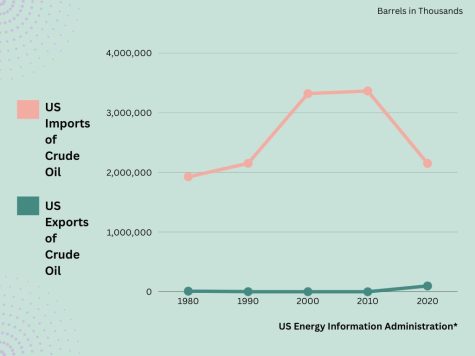
The efficiency of crude oil and gasoline for motor vehicles makes petroleum highly valuable and in turn, a method of the economic rationale for the approval of the environmentally damaging Willow Project. Environmental science teacher Paul Hage recognizes the national economic significance of the finite resource of oil despite the environmental side of the debate.
“Viewing [the Willow Project] through an economic lens, oil is a finite, non-renewable resource. Our reserves are low, and as we move forward and continue to use up our petroleum, we’re going to be forced to find it in more extreme places,” Hage said.
Additionally, the results of accepting this oil drilling plan will benefit the country’s general population after the recent surge of consumer prices due to inflation. In particular, regular gasoline prices rose over 49% simply within the year 2022. The Willow Project offers a solution — without the need to import oil from foreign countries, avoiding excessive taxes and fees for international transport, gasoline prices have a chance of reducing significantly. The importance of this resonates with families across the U.S., particularly low-income families hit hard by recent stages of inflation, as a relief to the ever-growing budget of transportation in the modern day.
Many Alaskans also argue that the new oil drilling project will provide a much-needed source of revenue for the state of Alaska through the production of billions of dollars of economic activity and tax revenue for the flagging economy. Consequently, a number of Alaskans favor the idea of its opportunity to open up jobs for Alaskans and grow the state’s labor force. For these reasons, various Alaskan representatives in the bipartisan congressional delegation have supported the Willow Project, along with certain groups of Alaskan natives on the North slope, pledging the importance of this new source of revenue for Alaska’s economy in aiding education and health care.
However, the U.S. is one of the most self-reliant countries in the world already, a title that has played a significant role in the recent age of politics in the U.S. Because of this, the significance of the Willow Project’s economic opportunity doesn’t quite compare in the grand scheme of the U.S. economy. Ultimately, compared to the 8 million barrels a day being imported, the 600 million barrels earned from the Willow Project would last only 75 days without any additional imports. In reality, the U.S. economy can not avoid importing oil solely because of this project.
Additionally, as inflation prices have begun to swoop back up, the Willow Project’s economic rationale may not remain so important to low-income families. The various economic benefits that supporters of the Willow Project offer are only surface-level ideas and reflect a narrow-minded approach to the root cause of economic dependency and inflation.
Crippling Carbon
Nothing comes without its consequence: the economic benefits of the Willow Project are countered by equally harsh environmental effects. Arguably, the most troublesome consequence of the Willow Project is the excessive carbon dioxide release through its burning process. In fact, the burning of oil using Alaska’s petroleum reserves is expected to produce over 250 million tons of carbon dioxide. The equivalent of such a catastrophe would be the release of carbon dioxide from 66 coal plants annually or adding 2 million gas-powered cars on the road. This carbon dioxide is released into the atmosphere through the oil drilling process — as a hydrocarbon fuel, like gasoline, gets combusted or burned, the excessive carbon gas combines with oxygen in the air and effectively alters the natural levels of CO2 gas in the atmosphere. Besides releasing carbon dioxide gas, oil extraction also releases methane, the most significant climate change accelerant. While methane is released less rapidly than carbon dioxide, it is still a great concern due to its efficient power of trapping heat in the atmosphere.
But what does the increase in carbon dioxide and methane emissions mean for the climate? The repercussions of an incremental increase in the release of these gasses are best explained by the idea of the greenhouse effect and the detrimental consequences to the greenhouse effect through an increased use of fossil fuels. The greenhouse effect, as defined by NASA, is when gasses in Earth’s atmosphere trap solar energy in the form of heat, making the Earth warm enough for survival. While this effect is necessary for the Earth, an increase in greenhouse gasses means an increase in heat in the atmosphere.
“A greenhouse gas allows more heat to be conserved within the atmosphere, meaning more heat in the system. When you add extra greenhouse gasses, [there is] a global temperature increase over time,” Hage said. “[When] you’re talking about fossil fuels, the basic concept of climate change is that we’re taking old fossil carbon out, which has been locked away and sequestered, and putting it into the atmosphere artificially. And anytime that you are adding extra carbon to the system — in this case, carbon dioxide — you’re strengthening the effect of the greenhouse effect.”
Greenhouse gas emissions are not even the worst of the issue. In oil drilling, the environment gets increasingly harmed by malfunctions in the process. The effects of these emissions on our planet cause habitat destruction and loss of biodiversity in wildlife.
“[In] the process of getting the fossil fuels, there’s always some spills or accidental leaks of natural gas in the area — it’s never one hundred percent going where we want it to go. There’s always a little bit of loss from [drilling] that is going to hurt the environment,” Environmental Club president and senior Quinn Gillies said.
The combined effects of such a massive land-bearing project can lead to the tragic destruction of Alaskan land. Many Alaskan natives living closer to the project — the ones more directly affected by the establishment of reserves in the area — have expressed concern for the environmental impacts of the oil drilling and the health impacts for their indigenous populations.
Furthermore, an extensive number of endangered species face greater risk under the Willow Project in Alaska, including polar bears and caribou, because of the habitat degradation they will face during the oil drilling process.
Even though the Willow Project begins in Alaska, its approval affects everyone in the world. Since 1970, global carbon dioxide emissions have increased by 90%, and the Willow Project only projects an increase to that statistic. From an encompassing global viewpoint, the general increase in carbon emissions and global warming from this oil drilling project will surely cause issues for later generations.
“Burning fossil fuels affects the entire world. This increased use of fossil fuels is [definitely] going to harm the entire country,” Gillies said.
Going Green or Getting the Green?
Amidst the various arguments that can be made for or against the Willow Project, this recent approval pursues a question of morality in which many people are left to wonder: is the economy or the environment more important? While the idea of a self-sufficient economy may benefit U.S. citizens, the severe environmental costs that come with the Willow Project only grow larger as the Earth continues to be depleted of natural and finite resources. While 1 billion dollars is being spent on just the early stages of the project, that much money is taken away from potentially finding cleaner energy resources. Because of this, while the economic benefits can seem grand, the project’s long-term environmental consequences cause a much more impactful and long-lasting effect.
“When we talk about environmental degradation, if you’re talking about digging up oil, there is a big cost associated that’s not part of the initial price tag. If you think about the damage that’s caused by climate change, if you think about the damage that’s done to the ecosystem [and] to biodiversity — if you were to put monetary values on all those things, the true cost of digging in Alaska would be far higher than just the literal economic cost of going there and drilling. We’re going to have to eventually pay the true cost when we have to deal with the environmental issues,” Hage said. “That’s how we should view almost any environmental problem: what is the true cost of what we’re doing?”
“We eventually have to pay the true cost.”
— Paul Hage
To counter the extent of damage already done, the World Bank estimated $90 trillion to spend on the climate effort by 2030. Compared to the $8 to $17 billion that is estimated to be earned from the Willow Project, the environmental cost is overwhelming.
“There are going to be more long-term costs associated with climate change than the short-term possible benefits of reduced gas prices. The economic benefit will [not] outweigh the long-term cost of environmental damage that we’re causing,” Gillies said.
Even the economic benefits of the Willow Project and the fantasy of a self-sufficient and energy-independent U.S. comes with multiple risks. For example, the hypothesized decrease in gas prices as a result of the Willow Project has a limited chance of execution due to a number of factors, including the six years of production required for gasoline from the Willow Reserve to be utilized. Instead, the money from the Willow Project has a greater chance of benefiting the ConocoPhillips oil company than the general population. Additionally, the theoretical energy independence of the U.S. could not be all that it seems, considering its possible effect on international relations.
“This project will ultimately help us become [less] reliant on the Middle East’s oil, which could start more tensions,” sophomore Amelia Geistler said.
Overall, it is evident that the cost of the only Earth we have is greater than that of a finite amount of crude oil. The effects of the Willow Project’s approval will echo across generations in the future when the Earth becomes unmanageable and unsolvable in its environmental degradation.
“The negatives [of the Willow Project] outweigh the benefits because if there is [no] Earth, there is no us. We are setting up the younger generations for failure. The whole world needs to be practical about the long-term effects. The Willow Project will affect young generations, and it’s up to us to be the change,” Geistler said.
Doing Our Part
Despite the severity of the Willow Project’s outcomes in the project’s approval, the future of the planet still manages to remain a malleable problem, which gives hope in countering this excessive environmental damage. The UN reports that at the rate of environmental damage now, there is less than a decade left for irreversible climate change to occur globally. It is up to us as a community to prevent this statistic from coming true. The idea of being the change can seem overwhelming, but in reality, the smallest adjustments in each person’s daily life could make the greatest difference years later when immediate environmental consequences begin to show.
The primary concern with the Willow Project reflects an unmanageable increase in carbon dioxide in the atmosphere. The best way for each individual to counteract the effects is by managing their carbon footprint. A carbon footprint is the total amount of greenhouse gasses that are generated by a person’s actions. Focusing on reducing your carbon footprint can include something as simple as the diet you eat, but can have long-term effects that potentially save our planet from its approaching collapse.
How much Carbon does your family create? Check out CoolClimate Network here.
“You can view a lot of actions through a carbon lens. The products you buy daily contribute to your carbon footprint,” Hage said.
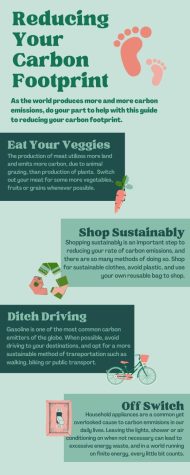
Besides personal carbon footprint reduction, we can work as a community to prevent the excessive burning of fossil fuels by using renewable energy sources. Wind and solar energy sources emit much lower greenhouse gasses than fossil fuels and can cost even less to extract than oil. The efficiency of renewable energy may not compare completely with coal or oil, but at the cost it saves environmentally, it is a much stronger alternative to fossil fuels.
“If you get an electric vehicle instead of a gas-powered vehicle, the [environmental] effects are a bit better. Moving away from fossil fuels [and] towards more sustainable energy sources creates just as many — if not more — jobs. In general, fossil fuel use affects everyone globally, and we should promote renewable sources instead,” Gillies said.
Among the extensive drilling debate associated with the Willow Project, the world has gotten a wake-up call to the looming dangers of such common environmental damage. After years of environmental struggle, the state of the planet can often leave communities feeling hopeless in reversing the damage, especially when the same problems that caused such harmful environmental effects are being approved again and again by governments and then rationalized for political or economic reasons. At the level of damage our planet has endured, the cost of the Earth should not be a debatable topic. But this seemingly impossible change starts with each and every person who cares — and if the Willow Project teaches us anything, it is that we must step up and face the climate crisis.
“At the level of damage our planet has endured, the cost of the Earth should not be a debatable topic.”
“We have a moral responsibility to try our best to save the environment. Just pushing little bits at a time, chipping away at [the issue], it’s going to make a huge impact,” Gillies said. “Regardless of whether or not we can, at this point, we have to.”
This story was originally published on Pathfinder on April 14, 2023.






![It was definitely out of my comfort zone to get [the dress] and decide I loved it enough not to wait and risk not having something that memorable.](https://bestofsno.com/wp-content/uploads/2024/04/Precious_20180902_JRS_00008_ed1.jpg)
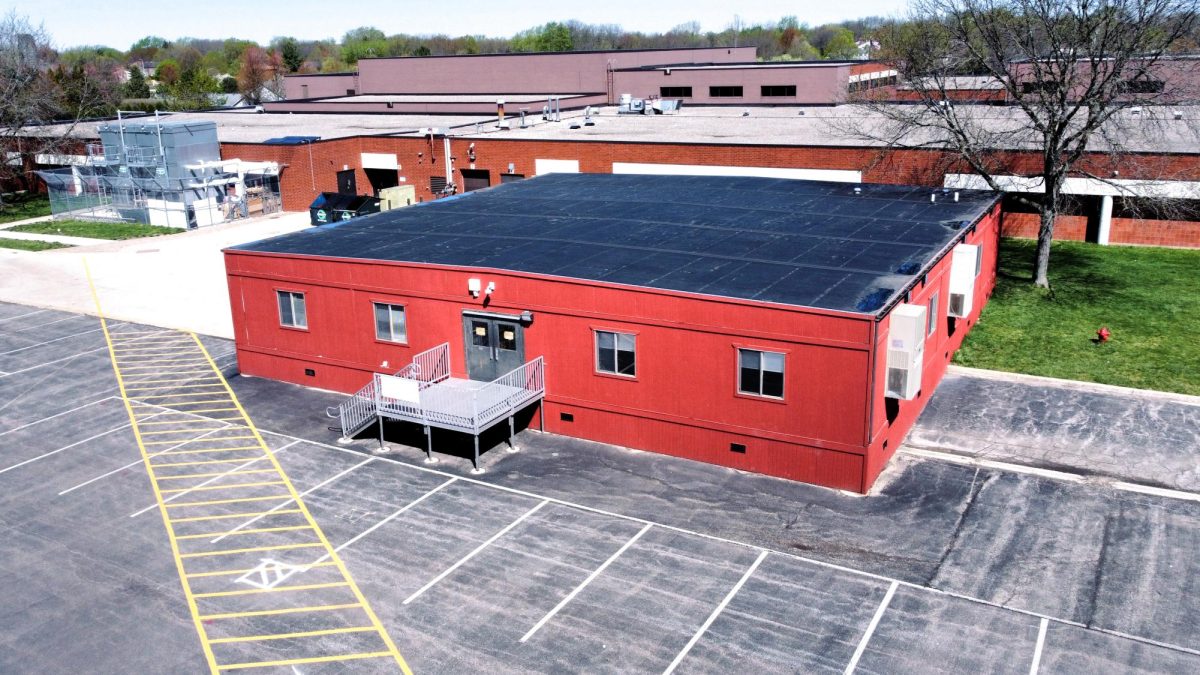
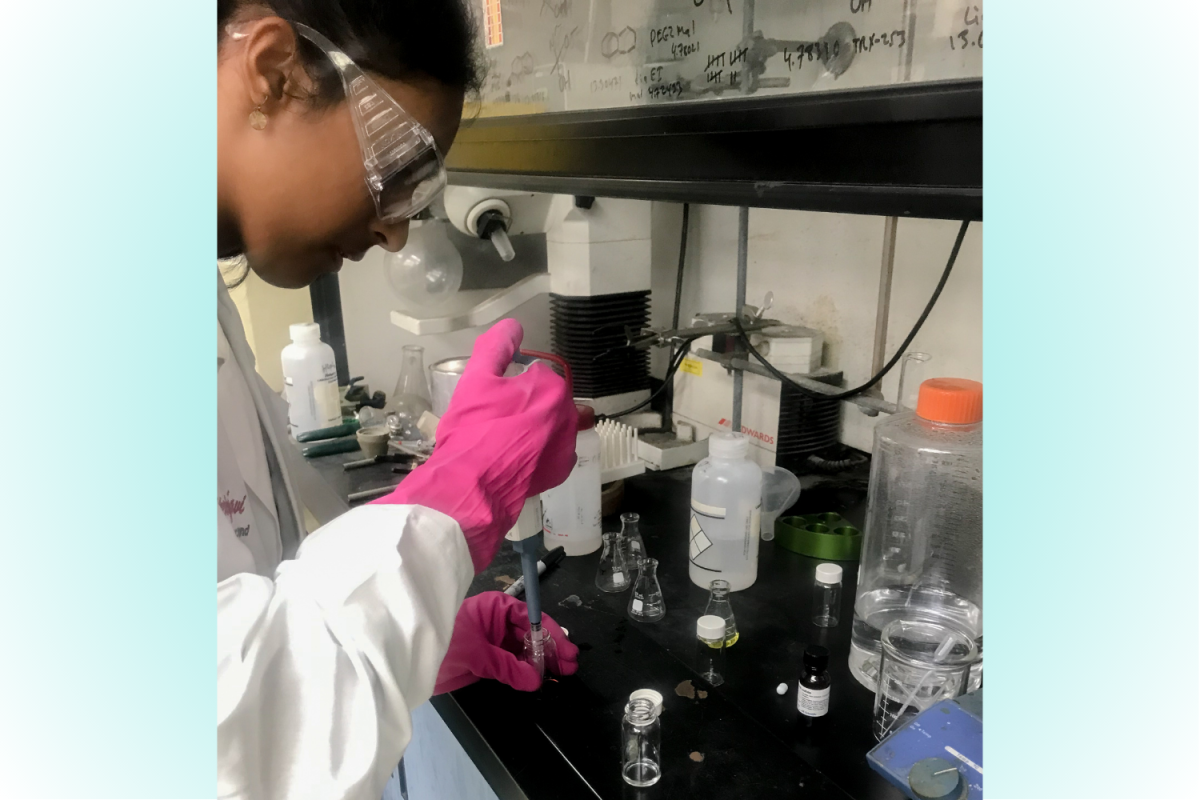





![In their full runway outfits, (from left) Audrey Lee 25, Olivia Lucy Teets, 25, Fashion Design teacher Ms. Judy Chance, and Xueying Lili Yang pose for a photo. All three girls made it to Austin Fashion Week by getting in the top 10 in a previous runway show held by Shop LC.
[I like my students] creativity and how they can look at a fabric and make it their own, Ms. Chance said.](https://bestofsno.com/wp-content/uploads/2024/04/IMG_9686-e1714088765730-1129x1200.jpeg)
















![IN THE SPOTLIGHT: Junior Zalie Mann performs “I Love to Cry at Weddings,” an ensemble piece from the fall musical Sweet Charity, to prospective students during the Fine Arts Showcase on Wednesday, Nov. 8. The showcase is a compilation of performances and demonstrations from each fine arts strand offered at McCallum. This show is put on so that prospective students can see if they are interested in joining an academy or major.
Sweet Charity originally ran the weekends of Sept. 28 and Oct. 8, but made a comeback for the Fine Arts Showcase.
“[Being at the front in the spotlight] is my favorite part of the whole dance, so I was super happy to be on stage performing and smiling at the audience,” Mann said.
Mann performed in both the musical theatre performance and dance excerpt “Ethereal,” a contemporary piece choreographed by the new dance director Terrance Carson, in the showcase. With also being a dance ambassador, Mann got to talk about what MAC dance is, her experience and answer any questions the aspiring arts majors and their parents may have.
Caption by Maya Tackett.](https://bestofsno.com/wp-content/uploads/2024/02/53321803427_47cd17fe70_o-1-1200x800.jpg)
![SPREADING THE JOY: Sophomore Chim Becker poses with sophomores Cozbi Sims and Lou Davidson while manning a table at the Hispanic Heritage treat day during lunch of Sept 28. Becker is a part of the students of color alliance, who put together the activity to raise money for their club.
“It [the stand] was really fun because McCallum has a lot of latino kids,” Becker said. “And I think it was nice that I could share the stuff that I usually just have at home with people who have never tried it before.”
Becker recognizes the importance of celebrating Hispanic heritage at Mac.
“I think its important to celebrate,” Becker said. “Because our culture is awesome and super cool, and everybody should be able to learn about other cultures of the world.”
Caption by JoJo Barnard.](https://bestofsno.com/wp-content/uploads/2024/01/53221601352_4127a81c41_o-1200x675.jpg)



